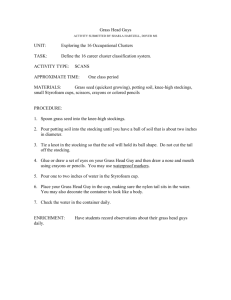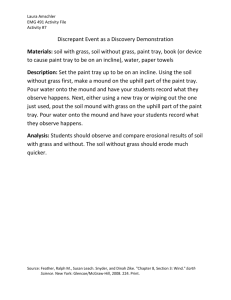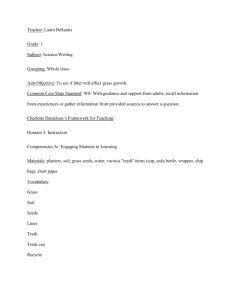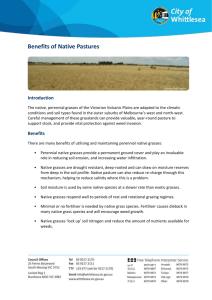Grassland Management for Stud Farms – Fiona McKenna
advertisement
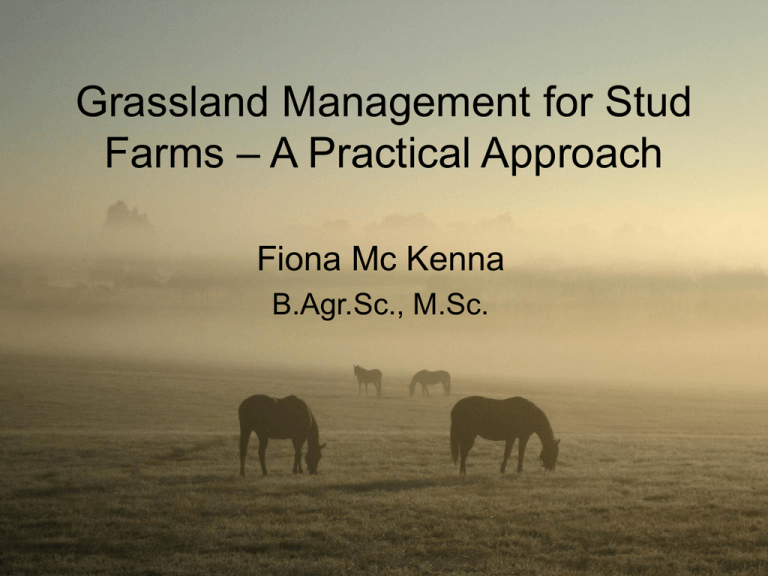
Grassland Management for Stud Farms – A Practical Approach Fiona Mc Kenna B.Agr.Sc., M.Sc. What is Quality Pasture? • • • • • Good grass cover Thick sod and deep root system Optimum soil fertility and pH Free from weed infestations Free draining What will Soil Analysis show? • • • • • Type of soil Fertility of the soil Soil pH Nutrient deficiencies Fertiliser and liming recommendations What are the Soil Nutrients? • Macronutrients – Nitrogen, Phosphorus, Potassium, Calcium, Magnesium, Sulfur • Micronutrients – Boron, Chlorine, Copper, Iron, Manganese, Molybdenum, Zinc, Nickel, Cobalt, Iodine and Selenium What is Soil pH? • • • • • Soil pH can range between 3 – 8 Optimum pH between 6.0 and 7.0 Effects the nutrient availability to plants Effects the microbial activity in the soil Acid pH requires liming Why Fertilise? • • • • Replace nutrients removed Improve soils that are naturally infertile Fertilisation of soils is recycling Types: Organic and Inorganic Types of Fertiliser • Organic – animal waste and manure - Slow releasing and longer lasting - Improves the soil texture • Inorganic – artificial N, P and K - Quick reaction and fast growth Benefits of Forage Analysis • • • • Profile of the nutrients Highlights nutritional deficiencies Balance feeding as required Manage and reduce cost of feed budget Grassland Management • • • • Grass is the most economic feed available Efficient use can reduce the feed bill Take a long term approach Yearly grassland management plan Grassland Management • Topping – essential during the growing season, start mid May to maintain quality • Harrowing – spreads manure, levels ground, lifts dead grass • Rolling – effective for poached ground, use only when required Grassland Management • • • • Mixed grazing – cattle and sheep Spiking – useful for shallow compaction Direct drilling or broadcasting of new seed Ploughing – last resort for plough pan, horse sick pasture, excessive ragwort Weed Management • • • • • Docks – soil with a high N content Buttercup – soil with poor drainage Ragwort – the ever lasting problem Top weeds before seed establishment Good grass cover suppresses weed growth Which Grass Species? • Grasses – Red fescue, cocksfoot, meadow grasses, crested dogs tail, timothy, ryegrass, white clover • Herbs – Dandelion, yarrow, ribwort plantain, chicory, burnet Nutritional Value of Grass? • • • • Grasses have different nutrient values Dependant on soil nutrients Maturity of the grass Time of year Grass Cover • Close paddocks in October/ November for spring grazing • Poor grass cover will lead to poaching and a slower recovery period • Open cover is an opportunity for weeds Rotation, Rotation, Rotation • Identify winter/summer paddocks • 3 to 5 weeks recovery period after tight grazing during growing season • Winter rotations can be less frequent increase area size, good grass cover Key Points For Quality Pasture • • • • • • Maintain good grass cover Regular topping of paddocks Mixed grazing with cattle and sheep Rotation of paddocks Maintain soil fertility and pH All weather paddock or feeding area
